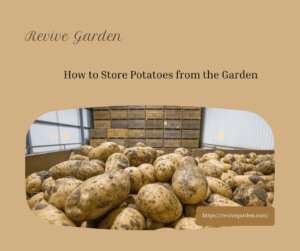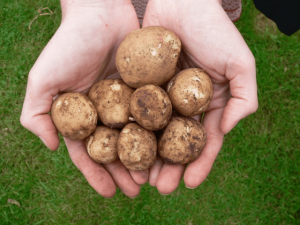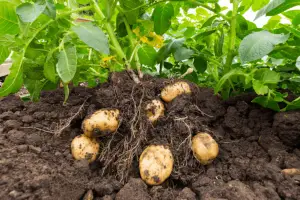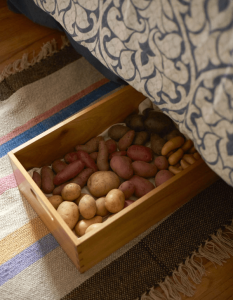Table of Contents
 Do you make good use of your land and grow your own potatoes? If so, you may already know that the ideal harvesting time is somewhere in October or before the ground freezes. If you have grown it in a large area, you might harvest enough to last you months! You will never have to purchase potatoes from the grocery store since you’ve already got organic ones back home. Wouldn’t it be just great?
Do you make good use of your land and grow your own potatoes? If so, you may already know that the ideal harvesting time is somewhere in October or before the ground freezes. If you have grown it in a large area, you might harvest enough to last you months! You will never have to purchase potatoes from the grocery store since you’ve already got organic ones back home. Wouldn’t it be just great?Do you know how to store potatoes from the garden? It’s essential to understand all the aspects of proper storage if you are planning to use the harvest for several months. Continue reading, and you’ll find out all about harvesting and storing potatoes from your garden.
Storing new potatoes

New potatoes are always a favorite. New potatoes can be harvested much sooner than the main crop. Keep a lookout for these after the plant starts flowering. These small tubers are ready to eat in just about a month after you have planted the crop.
You’ll remember these from the soft skin that scrapes off easily. New potatoes are usually eaten with the skin since it’s soft and chewable.
- Pick a warm day, with no rain to go digging for the new potatoes.
- Reach out under the soil for these small tubers taking care not to damage the rest of the plant.
- New potatoes cannot be stored for several months, like the main crop.
- They’ll stay fresh for a few days as long as you keep them in the refrigerator inside a paper bag.
- Remember not to wash them before storing new potatoes. They are best stored dry. It will keep them fresh for longer.
Harvesting Potatoes

The maincrop potatoes, or the large ones with harder skin, will take around 15 weeks to mature after planting. So once you’ve picked the new potatoes, the rest of the tubers will continue to grow for several weeks.
The principal crop of potatoes is ready around October. The foliage will begin to die even before that, somewhere in mid-August. After the foliage dies completely, wait a couple of weeks for the skin of the tubers to harden up. Remember that you have to harvest before the ground freezes, which can vary depending on where you live.
Once you are ready to make the harvest, here are the steps to follow:
- Stop watering the crop a couple of weeks before the harvest. Doing so will allow the skin of the potatoes to toughen up. Let the foliage die entirely.
- Choose a warm day to dig the crop when it hasn’t rained for a couple of days, at least. You want the ground to be parched.
- Dig out the crop using a spade or a spading fork. Dig gently, so that you don’t bruise the potatoes. Bruised potatoes will have a lower life span.
Drying and Curing
Once you have harvested the entire potato crop, you are ready to treat and store them. Before storing garden potatoes, they need to be dried and cured. This step will enhance their shelf life. Here are the steps to take:
Drying
Moist potatoes will start decaying soon. You want them completely dry to be able to store them for longer. Here is what you need to do:
- Leave the harvested potatoes out in the garden to dry for a couple of hours.
- Keep them covered, so they don’t get direct sunlight.
- Use a soft brush to brush off the excess soil hanging to the potatoes, but do not wash them.
Curing
Curing the potatoes allows the skin to grow thicker, which, again, increases their shelflife. It also heals the bruises that few of the potatoes might have attained during harvesting. Follow the steps.
- Lay the tubers out in an open tray lined with newspaper.
- Cover them loosely with a cloth.
- Place the tray in a dark place that’s just a bit humid. The temperature of the surrounding should be around 65 F.
- Leave them in this position for around ten days.
Storing

Separate the potatoes with cuts and bruises before storing the rest of the harvest. The ones that have been separated can be used right away. This is how to preserve potatoes:
- Once the potatoes are cured, transfer them to a cool, dark room with little or no humidity.
- Store them in a well-ventilated container or bin that has ventilation holes on the sides and the bottom.
- Do not pile them all up in a single container and make sure that each of the pieces gets sufficient air.
- Remember not to store the potatoes in the refrigerator as they will shrivel up soon and lose their texture and flavor.
Checking
- Keep checking on the stored potatoes every couple of days, at least.
- Remove the spuds with your hands if they start forming on any of the tubers.
- Use the thinner-skinned tubers first as they won’t stay fresh for very long. Those with hard skins can be used for over eight months.
Avoid green potatoes
We have all grown up hearing that “green potatoes” are a big no-no! And it’s true! The green part contains solanine, which is a toxic alkaloid and can cause illness. Avoid excessive exposure to the sun during harvesting and store the potatoes in a dark place since sunlight is the main reason for the development of solanine.
However, if you still find green portions in the potatoes when using it for cooking, cut it off, so it doesn’t go in your food.
Conclusion
That’s how to store potatoes from the garden after harvesting them. It’s not that hard. If you have a large backyard, make the most of it, and grow your own vegetables.
Home-grown vegetables are organic and healthy. They are also fresher and tastier than those you get from a store. Of course, the added benefit is all the money you’ll be saving if you’re self-sufficient in your food.
